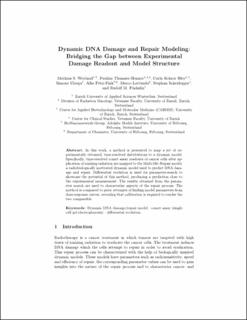Please use this identifier to cite or link to this item:
https://doi.org/10.21256/zhaw-20501Full metadata record
| DC Field | Value | Language |
|---|---|---|
| dc.contributor.author | Weyland, Mathias | - |
| dc.contributor.author | Thumser-Henner, Pauline | - |
| dc.contributor.author | Rohrer Bley, Carla | - |
| dc.contributor.author | Ulzega, Simone | - |
| dc.contributor.author | Petri-Fink, Alke | - |
| dc.contributor.author | Lattuada, Marco | - |
| dc.contributor.author | Scheidegger, Stephan | - |
| dc.contributor.author | Füchslin, Rudolf Marcel | - |
| dc.date.accessioned | 2020-09-17T12:53:58Z | - |
| dc.date.available | 2020-09-17T12:53:58Z | - |
| dc.date.issued | 2019 | - |
| dc.identifier.isbn | 978-3-030-21732-7 | de_CH |
| dc.identifier.isbn | 978-3-030-21733-4 | de_CH |
| dc.identifier.uri | https://digitalcollection.zhaw.ch/handle/11475/20501 | - |
| dc.description.abstract | In this work, a method is presented to map a set of experimentally obtained, time-resolved distributions to a dynamic model. Specifically, time-resolved comet assay readouts of cancer cells after application of ionizing radiation are mapped to the Multi-Hit-Repair model, a radiobiologically motivated dynamic model used to predict DNA damage and repair. Differential evolution is used for parameter-search to showcase the potential of this method, producing a prediction close to the experimental measurement. The results obtained from the parameter search are used to characterize aspects of the repair process. The method is compared to prior attempts of finding model parameters from dose-response curves, revealing that calibration is required to render the two comparable. | de_CH |
| dc.language.iso | en | de_CH |
| dc.publisher | Springer | de_CH |
| dc.relation.ispartofseries | Communications in Computer and Information Science | de_CH |
| dc.rights | Licence according to publishing contract | de_CH |
| dc.subject | Computational medicine | de_CH |
| dc.subject | Dynamic DNA damage/repair model | de_CH |
| dc.subject | Comet assay (single cell gel electrophoresis) | de_CH |
| dc.subject | Differential evolution | de_CH |
| dc.subject.ddc | 572: Biochemie | de_CH |
| dc.title | Dynamic DNA damage and repair modelling : bridging the gap between experimental damage readout and model structure | de_CH |
| dc.type | Konferenz: Paper | de_CH |
| dcterms.type | Text | de_CH |
| zhaw.departement | Life Sciences und Facility Management | de_CH |
| zhaw.organisationalunit | Institut für Computational Life Sciences (ICLS) | de_CH |
| zhaw.publisher.place | Cham | de_CH |
| dc.identifier.doi | 10.1007/978-3-030-21733-4_10 | de_CH |
| dc.identifier.doi | 10.21256/zhaw-20501 | - |
| zhaw.conference.details | XIII International Workshop on Artificial Life and Evolutionary Computation (WIVACE), Parma, Italy, 10-12 September 2018 | de_CH |
| zhaw.funding.eu | No | de_CH |
| zhaw.originated.zhaw | Yes | de_CH |
| zhaw.pages.end | 137 | de_CH |
| zhaw.pages.start | 127 | de_CH |
| zhaw.parentwork.editor | Cagnoni, Stefano | - |
| zhaw.parentwork.editor | Mordonini, Monica | - |
| zhaw.parentwork.editor | Pecori, Riccardo | - |
| zhaw.parentwork.editor | Roli, Andrea | - |
| zhaw.parentwork.editor | Villani, Marco | - |
| zhaw.publication.status | acceptedVersion | de_CH |
| zhaw.series.number | 900 | de_CH |
| zhaw.publication.review | Peer review (Publikation) | de_CH |
| zhaw.title.proceedings | Artificial Life and Evolutionary Computation | de_CH |
| zhaw.funding.snf | 163435 | de_CH |
| zhaw.webfeed | Biomedical Simulation | de_CH |
| zhaw.funding.zhaw | Phantom- and Model-based Optimisation of Medical Imaging Modalities | de_CH |
| zhaw.author.additional | No | de_CH |
| zhaw.display.portrait | Yes | de_CH |
| Appears in collections: | Publikationen Life Sciences und Facility Management | |
Files in This Item:
| File | Description | Size | Format | |
|---|---|---|---|---|
| 2019_Weyland-etal_Dynamic-DNA-damage-and-repair-modeling.pdf | Accepted Version | 226.27 kB | Adobe PDF |  View/Open |
Show simple item record
Weyland, M., Thumser-Henner, P., Rohrer Bley, C., Ulzega, S., Petri-Fink, A., Lattuada, M., Scheidegger, S., & Füchslin, R. M. (2019). Dynamic DNA damage and repair modelling : bridging the gap between experimental damage readout and model structure [Conference paper]. In S. Cagnoni, M. Mordonini, R. Pecori, A. Roli, & M. Villani (Eds.), Artificial Life and Evolutionary Computation (pp. 127–137). Springer. https://doi.org/10.1007/978-3-030-21733-4_10
Weyland, M. et al. (2019) ‘Dynamic DNA damage and repair modelling : bridging the gap between experimental damage readout and model structure’, in S. Cagnoni et al. (eds) Artificial Life and Evolutionary Computation. Cham: Springer, pp. 127–137. Available at: https://doi.org/10.1007/978-3-030-21733-4_10.
M. Weyland et al., “Dynamic DNA damage and repair modelling : bridging the gap between experimental damage readout and model structure,” in Artificial Life and Evolutionary Computation, 2019, pp. 127–137. doi: 10.1007/978-3-030-21733-4_10.
WEYLAND, Mathias, Pauline THUMSER-HENNER, Carla ROHRER BLEY, Simone ULZEGA, Alke PETRI-FINK, Marco LATTUADA, Stephan SCHEIDEGGER und Rudolf Marcel FÜCHSLIN, 2019. Dynamic DNA damage and repair modelling : bridging the gap between experimental damage readout and model structure. In: Stefano CAGNONI, Monica MORDONINI, Riccardo PECORI, Andrea ROLI und Marco VILLANI (Hrsg.), Artificial Life and Evolutionary Computation. Conference paper. Cham: Springer. 2019. S. 127–137. ISBN 978-3-030-21732-7
Weyland, Mathias, Pauline Thumser-Henner, Carla Rohrer Bley, Simone Ulzega, Alke Petri-Fink, Marco Lattuada, Stephan Scheidegger, and Rudolf Marcel Füchslin. 2019. “Dynamic DNA Damage and Repair Modelling : Bridging the Gap between Experimental Damage Readout and Model Structure.” Conference paper. In Artificial Life and Evolutionary Computation, edited by Stefano Cagnoni, Monica Mordonini, Riccardo Pecori, Andrea Roli, and Marco Villani, 127–37. Cham: Springer. https://doi.org/10.1007/978-3-030-21733-4_10.
Weyland, Mathias, et al. “Dynamic DNA Damage and Repair Modelling : Bridging the Gap between Experimental Damage Readout and Model Structure.” Artificial Life and Evolutionary Computation, edited by Stefano Cagnoni et al., Springer, 2019, pp. 127–37, https://doi.org/10.1007/978-3-030-21733-4_10.
Items in DSpace are protected by copyright, with all rights reserved, unless otherwise indicated.